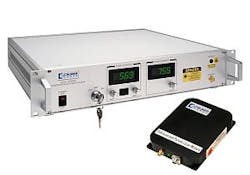Calmar 780 nm benchtop femtosecond laser for multiphoton imaging microscopy
The Mendocino 780 nm benchtop femtosecond fiber laser from Calmar Laser (Sunnyvale, CA) features a selectable wavelength range of 765 to 780 nm, pulse width down to 0.1 ps with near transform-limited pulse shape and a negligible pedestal, and timing jitter down to 60 fs. Repetition rate can be specified from 10 to 50 MHz with a polarization maintaining output. Free-space and fiber-coupled outputs are available, and an RF synchronization output is provided as a trigger signal.
-----
PRESS RELEASE
Applications
- Biophotonics
- Terahertz radiation
- Seeding Ti:sapphire amplifiers
- Materials characterization
- Optical metrology
- Multiphoton imaging microscopy
Features
- Pulse energy up to 1 nJ
- Peak power up to 10 kW
- Wavelength selectable from 765 to 780 nm
- Pulse widths as short as 0.1 ps
- Near transform-limited output
- Linearly polarized output
- Minimal pulse pedestal
- Low timing jitter
- RF synchronization output
- Turnkey operation
- High stability
The 780 nm bench top femtosecond fiber laser (FPL-02R or FPL-03R) is a second harmonic generation (SHG) product of Calmar’s passively mode-locked fiber laser in C-band. It has excellent stability, reliability and turnkey operation, based on the proven C-band laser. Along with a portable design, this FPL series offers user-friendly front panel control knobs for flexible adjustment of output power. The wavelength can be selected from 765 to 780 nm range. The pulse width is as low as 0.1 ps with near transform-limited pulse shape and a negligible pedestal. The timing jitter is as low as 60 fs. The repetition rate can be specified from 10 to 50 MHz with a polarization-maintaining (PM) output. With up to 50 mW output power at 50MHz and 0.1 ps pulse width, the laser provides as high as 1nJ pulse energy and 10 kW peak power. Both free space output and fiber-coupled output are available for the convenience of end users. An RF synchronization output is provided as a trigger signal.
Calmar’s FPL operation is highly stable, which significantly differentiates us from our competitors. Whenever our laser is turned on, it always starts in the same operation state. Calmar’s laser enables end users to focus on their work, not on the laser itself, while our competitors’ laser startup status is unpredictable, requiring constant adjustment during operation.
